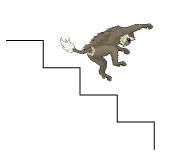Integers
Verify a − (−b) = a + b for the following values of a and b.
(i) a = 21, b = 18
(ii) a = 118, b = 125
(iii) a = 75, b = 84
(iv) a = 28, b = 11
(i) a = 21, b = 18
a − (−b) = 21 − (−18) = 21 + 18 = 39
a + b = 21 + 18 = 39
∴a − (−b) = a + b = 39
(ii) a = 118, b = 125
a − (−b) = 118 − (−125) = 118 + 125 = 243
a + b = 118 + 125 = 243
∴a − (−b) = a + b = 243
(iii) a = 75, b = 84
a − (−b) = 75 − (−84) = 75 + 84 = 159
a + b = 75 + 84 = 159
∴ a − (−b) = a + b = 159
(iv) a = 28, b = 11
a − (−b) = 28 − (−11) = 28 + 11 = 39
a + b = 28 + 11 = 39
∴ a − (−b) = a + b = 39
Sponsor Area
Some More Questions From Integers Chapter
Rita goes 20 km towards east from a point A to the point B. From B, she moves 30 km towards west along the same road. If the distance towards east is represented by a positive integer then, how will you represent the distance travelled towards west? By which integer will you represent her final position from A?
![]()
In a magic square each row, column and diagonal have the same sum. Check which of the following is a magic square.
|
5 |
− 1 |
− 4 |
1 |
− 10 |
0 |
||
|
− 5 |
− 2 |
7 |
− 4 |
− 3 |
− 2 |
||
|
0 |
3 |
− 3 |
− 6 |
4 |
− 7 |
||
|
(i) |
(ii) |
||||||
Verify a − (−b) = a + b for the following values of a and b.
(i) a = 21, b = 18
(ii) a = 118, b = 125
(iii) a = 75, b = 84
(iv) a = 28, b = 11
A water tank has steps inside it. A monkey is sitting on the topmost step (i.e., the first step). The water level is at the ninth step.

(i) He jumps 3 steps down and then jumps back 2 steps up. In how many jumps will he reach the water level?
(ii) After drinking water, he wants to go back. For this, he jumps 4 steps up and then jumps back 2 steps down in every move. In how many jumps will he reach back the top step?
(iii) If the number of steps moved down is represented by negative integers and the number of steps moved up by positive integers, represent his moves in part (i) and (ii) by completing the following; (a) − 3 + 2 − … = − 8 (b) 4 − 2 + … = 8. In (a) the sum (− 8) represents going down by eight steps. So, what will the sum 8 in (b) represent?
Write down a pair of integers whose:
(a) sum is − 7
(b) difference is − 10
(c) sum is 0
(a) Write a pair of negative integers whose difference gives 8.
(b) Write a negative integer and a positive integer whose sum is − 5.
(c) Write a negative integer and a positive integer whose difference is − 3.
In a quiz, team A scored − 40, 10, 0 and team B scored 10, 0 − 40 in three successive rounds. Which team scored more? Can we say that we can add integers in any order?
Find each of the following products:
(a) 3 × (− 1) (b) (− 1) × 225
(c) (− 21) × (− 30) (d) (− 316) × (− 1)
(e) (− 15) × 0 × (−18) (f) (− 12) × (− 11) × (10)
(g) 9 × (− 3) × (− 6) (h) (− 18) × (− 5) × (− 4)
(i) (− 1) × (−2) × (− 3) × 4
(j) (− 3) × (− 6) × (− 2) × (− 1)
Mock Test Series
Sponsor Area
NCERT Book Store
NCERT Sample Papers
Sponsor Area